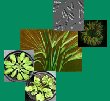| Beck, E; Heim, R; Hansen, J: Plant resistance to cold stress: Mechanisms and environmental signals triggering frost hardening and dehardening, J. Biosci., 29(4), 449-459 (2004), doi:10.1007/BF02712118 | |
| Abstract: This introductory overview shows that cold, in particular frost, stresses a plant in manifold ways and that the plant’s response, being injurious or adaptive, must be considered a syndrome rather than a single reaction. In the course of the year perennial plants of the temperate climate zones undergo frost hardening in autumn and dehardening in spring. Using Scots pine (Pinus sylvestris L.) as a model plant the environmental signals inducing frost hardening and dehardening, respectively, were investigated. Over 2 years the changes in frost resistance of Scots pine needles were recorded together with the annual courses of day-length and ambient temperature. Both act as environmental signals for frost hardening and dehardening. Climate chamber experiments showed that short day-length as a signal triggering frost hardening could be replaced by irradiation with far red light, while red light inhibited hardening. The involvement of phytochrome as a signal receptor could be corroborated by respective night-break experiments. More rapid frost hardening than by short day or far red treatment was achieved by applying a short period (6 h) of mild frost which did not exceed the plant’s cold resistance. Both types of signals were independently effective but the rates of frost hardening were not additive. The maximal rate of hardening was − 0.93°C per day and frost tolerance of < − 72°C was achieved. For dehardening, temperature was an even more effective signal than day-length. |

Letzte Änderung 06.07.2020

